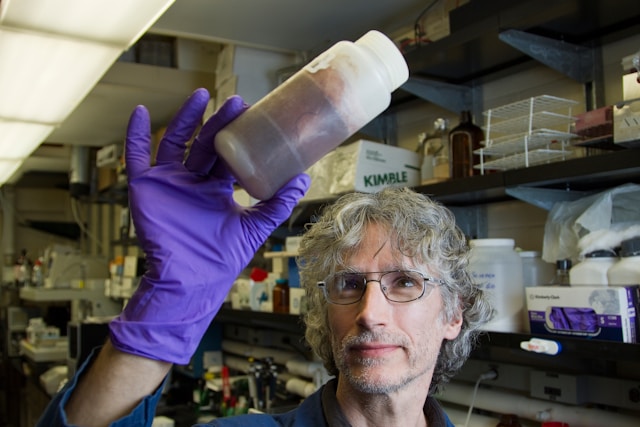In a remarkable scientific breakthrough that has left the academic world scrambling for answers, Dr. Rebecca Hoppington, a distinguished expert in lagomorphic reproductive physiology, claims to have finally unraveled the perplexing mystery of how the Easter Bunny lays eggs. For decades, this enigma has confounded scientists and puzzled children worldwide, but Dr. Hoppington’s recent findings shed light on this egg-citing phenomenon.
Published in the esteemed journal Cracked Discoveries, Dr. Hoppington’s research proposes a fascinating theory: the Easter Bunny possesses a unique adaptation in its reproductive system, allowing it to produce and lay eggs. Through meticulous observation and analysis of Easter Bunny specimens, Dr. Hoppington has uncovered evidence suggesting that the bunny’s reproductive organs undergo a remarkable transformation during the spring season.
“It appears that the Easter Bunny’s reproductive system undergoes a seasonal shift, triggered by environmental cues such as lengthening daylight and changes in temperature,” explains Dr. Hoppington. “During this time, specialized glands within the bunny’s body begin producing egg-like structures, which are then deposited in hidden nests across the countryside.
Dr. Hoppington’s findings challenge previous hypotheses that suggested the Easter Bunny’s eggs were magically transported or fabricated from unconventional materials. Instead, her research points to a more natural and biologically plausible explanation for this Easter tradition.
Still More Research Needed
“While the exact mechanisms behind the Easter Bunny’s egg-laying abilities are still being investigated, our research provides compelling evidence for the existence of a specialized reproductive adaptation unique to this species,” notes Dr. Hoppington. Despite the groundbreaking nature of Dr. Hoppington’s research, some skeptics have raised questions about the practicality of her findings. Critics argue that further empirical evidence is needed to support her claims, citing the difficulty in obtaining comprehensive data on the elusive Easter Bunny. Nevertheless, Dr. Hoppington remains optimistic about the implications of her research. “Understanding the biology of the Easter Bunny not only satisfies scientific curiosity but also enriches our appreciation for the cultural significance of this beloved holiday tradition,” she remarks.
What About the Colors?
Dr. Hoppington’s research also offers insight into another longstanding Easter mystery: the vibrant colors of the eggs laid by the Easter Bunny. Through careful analysis of egg samples collected from various Easter Bunny nests, Dr. Hoppington and her team have discovered that the eggs undergo a fascinating process of natural pigmentation. It appears that as the eggs develop within the bunny’s reproductive system, they come into contact with different naturally occurring dyes present in the environment, resulting in the striking array of colors observed in Easter egg hunts. This revelation not only adds a colorful dimension to our understanding of the Easter Bunny’s reproductive biology but also highlights the intricate interplay between genetics and environmental factors in shaping the appearance of these iconic holiday treasures.
As news of Dr. Hoppington’s discovery spreads, families around the world are eager to incorporate this newfound knowledge into their Easter celebrations. Whether the Easter Bunny’s egg-laying abilities will continue to captivate imaginations for generations to come remains to be seen. However, thanks to Dr. Hoppington’s pioneering research, one thing is certain: the mystery of the Easter Bunny’s eggs has cracked wide open.
About Dr. Rebecca Hoppington

Dr Rebecca Hoppington is a pioneering figure in the field of lagomorphic reproductive physiology, renowned for her groundbreaking research on the Easter Bunny’s egg-laying abilities. Born and raised in a small rural town, Dr. Hoppington’s early fascination with nature and wildlife set her on a path of scientific discovery.
After earning her bachelor’s degree in Delusional Studies, with a focus on the psychological aspects of belief systems, Dr. Hoppington pursued further studies in animal biology, specializing in lagomorphs. Her unconventional academic background, which included a brief stint in the world of used car sales and a detour as a political pundit, provided her with a unique perspective on the intersection of science and society. Dr. Hoppington’s career took a dramatic turn when she embarked on a research project aimed at demystifying the Easter Bunny’s elusive reproductive biology. Combining her expertise in animal behavior with her passion for unraveling mysteries, she dedicated herself to uncovering the truth behind this centuries-old enigma.
Through tireless fieldwork and rigorous scientific inquiry, Dr. Hoppington made significant strides in understanding the Easter Bunny’s reproductive physiology, culminating in her groundbreaking discovery of the bunny’s egg-laying mechanisms. Her research has not only garnered international acclaim but has also sparked a renewed interest in the biological underpinnings of holiday traditions. As she continues to push the boundaries of scientific knowledge, Dr. Hoppington remains committed to unraveling the mysteries of the natural world and inspiring future generations of curious minds.
******
Ms. Career Girl wishes you a truly Happy Easter!
This post is exclusively published on eduexpertisehub.com
Source link

